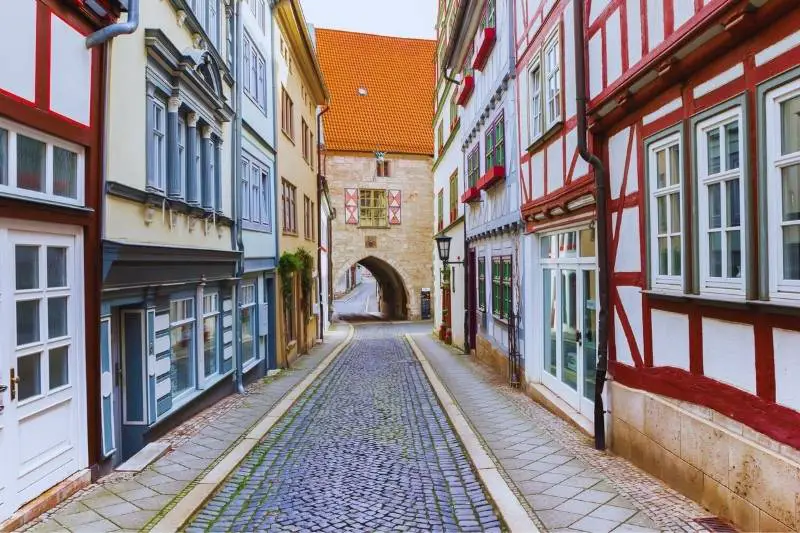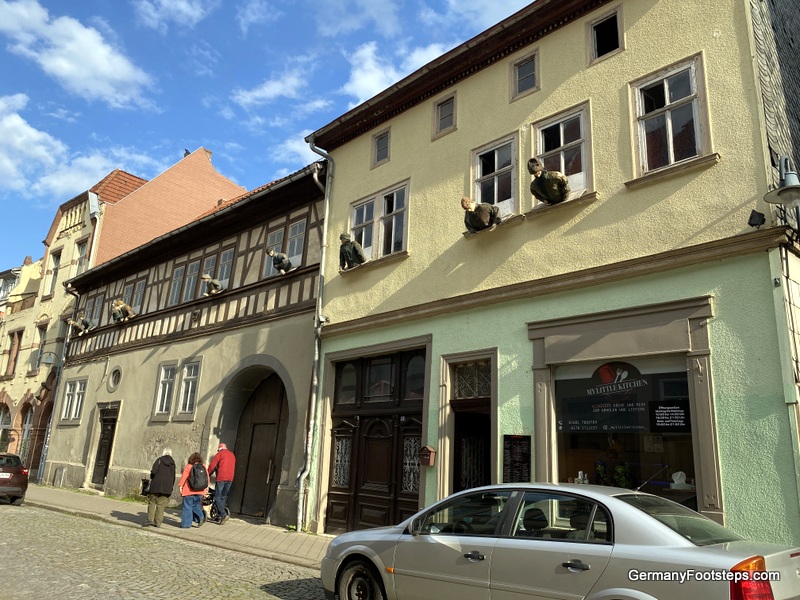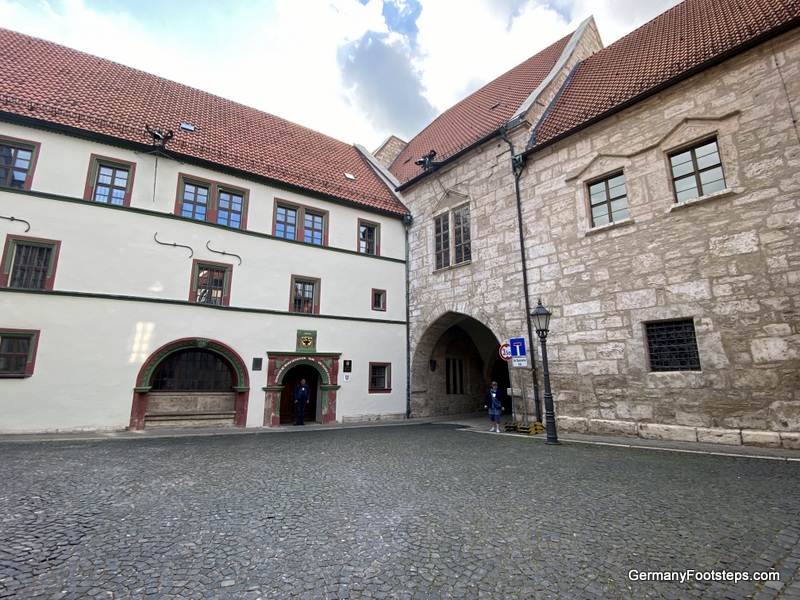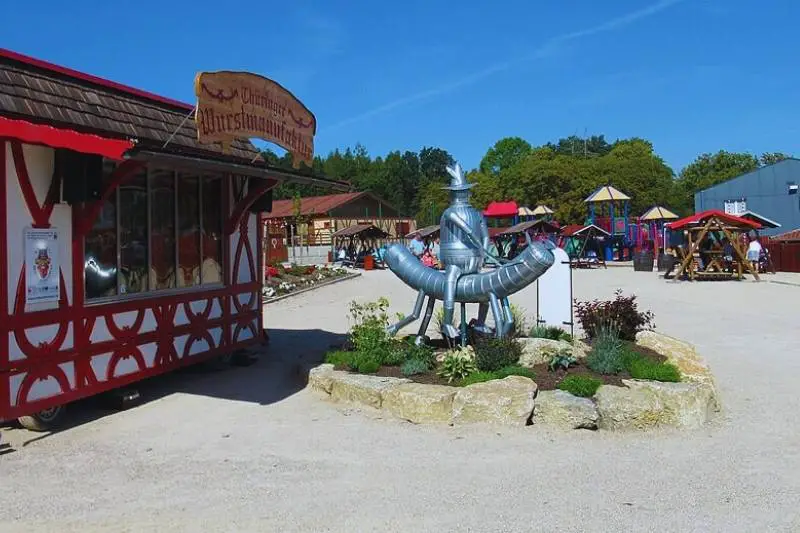If you’re planning a visit to Mühlhausen, you’re in for a delightful journey through time and culture. This article is your ultimate guide to the top activities and attractions in this historic German gem, curated to enhance your experience in the city.
Nestled in the heart of Germany – just 5 kilometers from the absolute geographical center, Mühlhausen boasts a tapestry of historical and modern experiences waiting to be uncovered. From the echo of church bells that have rung through the ages to the vibrant murals that grace the city with stories of its past, every street corner tells a tale.
As a traveler, you won’t just walk through Mühlhausen; you’ll wander through living history in this gorgeous Old Town.

It’s not just about the monuments and cobblestones; it’s the old buildings and vibe, the local flavors, and the serene green spaces that make Mühlhausen a true traveler’s delight. Whether you’re a history buff, a nature lover, or simply in search of beautiful German Old Towns, this city has something to offer.
It’s hard to find information in English on this town – maybe because it’s so good, the Germans want to keep it for themselves!
So, let’s delve into the heart of Mühlhausen and discover the treasures that make it unique.
Love Germany? Click here to download your free guide to ALL of Germany’s Amazing UNESCO sites. See all 52 of them!
A Brief History of Mühlhausen
Mühlhausen, a city steeped in history, is situated in the central German state of Thuringia and holds important historical significance owing to its rich past that dates back to the early Middle Ages.
The first documented mention of Mühlhausen dates to 967 AD, during the reign of Emperor Otto I in an imperial donation document. It developed around a Benedictine monastery and owes its early economic development to its location along the ancient trade route, the Via Regia, linking Frankfurt and Leipzig, which facilitated commerce and communication.
In the 12th century, Mühlhausen gained imperial freedom, which exempted it from the jurisdiction of local rulers and directly subjected the town to the Emperor’s authority, emboldening its autonomy. It was during this period that the city’s fortifications started to take form, parts of which are still evident in the remnants of the city’s walls and impressive gate structures, symbolizing its medieval strength.
The city played a pivotal role during the Peasants’ War (1524-1525), when it became a center for revolutionary Thomas Müntzer, a radical preacher and a contemporary of Martin Luther. Müntzer’s leadership in the war against feudalism and his subsequent execution in Mühlhausen emphasized the city’s role in the Reformation and social upheaval of the 16th century.

In the following centuries, Mühlhausen thrived as a member of the Hanseatic League, an influential medieval commercial and defensive confederation of merchant guilds and market towns in Northwestern and Central Europe.
Its involvement in the Hanseatic League enhanced its economic prosperity, primarily due to the wool and textile trade, fostering a period of cultural and architectural development, including the notable Gothic Divi Blasii church where Johann Sebastian Bach worked as an organist in 1707-1708.
The thirty Years’ War and subsequent conflicts led to periods of hardship for the city, but it managed to recover its former prosperity. In the 19th century, Mühlhausen evolved into an industrial center, especially with the coming of the railroad and the establishment of manufacturing enterprises.
Despite experiencing significant damage in World War II, Mühlhausen has preserved much of its historical architecture, such as its medieval churches and the majestic Rathaus (town hall). Today, Mühlhausen is not only a reflection of its rich historical tapestry but also a vibrant modern town that continues to celebrate its past through various cultural and educational avenues.
Top 7 Incredible Things To Do In Mühlhausen
Unfortunately, my time in Mühlhausen was cut short when there were issues with the train line here on the day I went to visit. I was not able to arrive until just before 5pm (after trying all day!) which meant I was unable to visit the museums personally. The information on these below comes from reliable research rather than personal experience.
The upside was that it was a sunny day in May and everything looked golden with the lowering sun. So pretty!
1. Wander the Old Town

Delving into the heart of Mühlhausen, the Old Town beckons with its immersive historical ambiance. Walking through its center, you can engage directly with the soul of medieval Germany, where every cobblestone and timber-framed house has a story to tell.
This area is a living museum, reflective of a time when Mühlhausen thrived as a free imperial city. The layout of the streets, the historical market square, and the preserved structures allow you to step back into a time long past yet vividly alive in the present.
It’s not just about landmarks; it’s an experience that envelops all the senses—small cafes, charming boutiques, and the sounds of church bells create a vibrant tapestry that celebrates the fusion of past and present.
There’s an interesting mix of architectural styles and plenty of gorgeous half-timbered houses. It all worked well together and added to the charm. I especially liked two buildings next to each other with statues leering at me out of the windows!!

Taking your time wandering round this Old Town. It’s a decent size and my absolute top thing to do in Mühlhausen.
2. Stroll Around the Historic City Walls

Mühlhausen’s historic city walls are more than mere fortifications; they are emblematic of the city’s resilience and strategic prominence throughout history. Originating from the 12th century, these battlements tell tales of protection against invaders, of thriving trade within the Hanseatic League, and of the self-governance that defined the city’s spirited community.
Today, the walls, along with the preserved gatehouses, provide a scenic promenade where history enthusiasts can absorb the aura of antiquity that hangs palpably in the air. Two kilometers of the original 2.8 kilometers of these walls still exist.
Particularly compelling is Mühlhausen’s ability to keep these stories accessible to everyone. As you trace the perimeter once patrolled by medieval guards, they not only gain insights into the architectural prowess of the Middle Ages but also enjoy peaceful views of the surrounding landscape—an enduring reminder of the city’s harmonious coexistence with nature throughout the centuries.
You can also walk on top of a section of this wall by Rabenturm (coming up next!).
3. Tour the Rabenturm (Raven Tower)

The formidable Rabenturm, or Raven Tower, stands as one of the most remarkable examples of Mühlhausen’s medieval military architecture. Its name, deriving from the tower’s use as a keep for ravens, adds a layer of historical mystique that captures the imagination.
The tower formed a crucial part of the city’s defensive ring and, through the years, has been a silent witness to the ebb and flow of the city’s fortunes.
Venturing into the Rabenturm is a journey upwards and backwards in time. You can climb the ancient steps once trodden by the city’s watchmen, moving past walls that have withstood centuries of upheaval. Within its walls, you can almost hear the echoes of history—clanking armor, the calls of the sentries, and the bustling sounds of a city confident in its defenses.
As you reach the summit, the tower rewards you with an exceptional panoramic view of Mühlhausen. From this vantage point, you can appreciate the city’s strategic position, surrounded by fertile land and well-trodden trade routes that once made it a thriving economic center.
4. Visit St. Mary’s Church (Marienkirche)

St. Mary’s Church, known locally as Marienkirche, is a beacon of historical and architectural splendor in Mühlhausen, deserving a place of honor on any itinerary. This grand church, with its origins dating back to the 14th century, stands as a symbol of the city’s medieval past and was once a cornerstone of the local community’s spiritual life.
It’s the second largest in Thuringia after Erfurt Cathedral. And it is BIG! Much bigger than this photo makes it appear.
Today, this church is no longer operational as a church but is a museum.
Why is a visit to St. Mary’s Church so essential? The church is not just a former house of worship, but an embodiment of the city’s rich history. As you step through its massive doors, they are greeted by towering Gothic arches and the soft light filtering through stained glass windows, depicting biblical stories and saints, lending the interior an ethereal ambiance that recalls the sanctity of ages gone by.
St. Mary’s played a pivotal role during significant historical events, including the Peasants’ War, where it served as a pulpit for the revolutionary ideologist Thomas Müntzer. You can learn about these incidents in this museum. It bears the marks of its tumultuous history, with centuries-old scars that tell a story of survival through political and religious upheavals.
The church not only offers a spiritual journey through its historical narrative but also provides a feast for art enthusiasts. The architecture itself, a masterful display of gothic style, commands appreciation for its ability to reach towards the heavens in both a literal and figurative sense.
Climbing the bell tower (which is 86.7 meters high) presents a unique opportunity for those seeking a different perspective on Mühlhausen. From the apex, you are graced with a breathtaking view of the labyrinthine streets and the rolling Thuringian countryside beyond, offering a tangible sense of connection to the historic landscape.
5. Discover the Mühlhausen Cultural Museum

The Museum of Cultural History in Mühlhausen is housed in a neo-Renaissance building originally built as a grammar school in the late 19th century. It offers an interesting journey through the city’s rich heritage.
Established in 1928 as a local history museum, it reopened after modernization in 2013. You’ll be drawn to its three main exhibitions: showcasing Mühlhausen’s significance as a Free Imperial City and a key Teutonic Order hub, displaying archaeological treasures spanning 6000 years to reveal cultural influences, and featuring a striking collection of over 100 paintings and graphics from Thuringia’s 20th-century art scene.
The museum stands out not only for its permanent displays but also for hosting impactful regional and national exhibitions, making it a must-visit destination for history enthusiasts, art lovers, and curious minds exploring Mühlhausen’s multifaceted past and creative essence.
6. Visit the Rathaus (Town Hall)

In the heart of Mühlhausen sits the Rathaus, an emblematic structure that is a showcase of the city’s heritage and an anchor to its identity as a once free imperial city. This illustrious town hall is far more than a mere administrative building; it’s a historical monument from its foundation in the 14th century to the present day.
Why the Rathaus earns its illustrious spot on this list is evident the moment it comes into view. Its exterior, characterized by elements of Gothic, Baroque and Renaissance architecture, draws you into a bygone era of bureaucratic importance and civic pride. It has quite a unique look and is nestled among the surrounding streets instead of by a big plaza.
The Rathaus’s significance is intertwined with Mühlhausen’s history; as the seat of municipal power, it has been a witness to the city’s evolution, decision-making, and governance through various markers in history, including the Peasants’ War and its stint under different rulers.
Peering inside, you’re treated to a rich tapestry of period features, such as the Great Hall, Gothic paintings, and stately council chambers which have hosted countless meetings over the centuries. The building is not only about admiring its historical features; it’s also home to an array of art pieces and exhibitions that bring the city’s past leaders, cultural narratives, and pivotal events to life.
7. Explore the 1st German Bratwurst Museum

The 1st German Bratwurst Museum in Mühlhausen is a cultural and culinary delight that pays homage to a dish synonymous with German gastronomy – the Bratwurst. This unique institution is not just a museum; it’s a celebration of one of Germany’s most famous exports, delving into its history, variations, and cultural significance with a blend of fun and educational exhibits.
This museum secured its place on the list of must-see attractions in Mühlhausen because it offers an exploration that engages all senses. You will be drawn into the world of Bratwurst from the moment they pass through the entrance, which resembles a giant Bratwurst.
The exhibits recount the journey of this humble sausage from its simple beginnings to its status as a culinary icon. You’ll discover the Bratwurst’s lineage that stretches back centuries, a time when regionally distinct spices and preparation methods were fiercely guarded.
The interactive displays at the museum are a treat for both adults and children alike, outlining how Bratwurst has influenced German culture beyond the dining table. Theories about its origin, the evolution of recipes, the variety of serving methods across different regions, and its place in festivals and public life are all covered within the museum’s engaging narrative.
This storytelling is complemented by tasting events, cooking demonstrations, and even the opportunity to learn how to make your own Bratwurst, complete with traditional spices.
Moreover, the museum immortalizes the Bratwurst in ways that transcend the historical. It also looks at the sausage’s place in contemporary culture, media, and humor, giving you a 360-degree view of its impact on daily life.
How To Get To Mühlhausen

If you’re planning a trip to Mühlhausen from elsewhere in Germany, rest assured, it’s a straightforward journey. Start by catching a train — Germany’s extensive railway network is not only efficient but also offers a scenic and relaxing way to travel. Your main hub will likely be the city of Erfurt, Thuringia’s capital, which is well-connected by train to major German cities like Berlin, Frankfurt, and Munich.
From Erfurt, you’ll find regular direct train services to Mühlhausen, with the journey typically lasting around an hour. The same services exists from Göttingen. These regional trains are comfortable and offer the chance to gaze out at the rolling Thuringian countryside as you travel.
Click here to check out Deutsche Bahn schedules and prices.
Of course, it was not so easy when I tried to make this journey but I’m sure it will go smoother for you!
You can also take a bus from Eisenach. Details are on the Deutsche Bahn link above.
If you prefer driving, the roads to Mühlhausen are just as inviting. Rent a car and navigate through the picturesque landscapes of Germany at your own pace. Mühlhausen is connected by the A38 and the B249, which are part of the well-maintained German autobahn and federal road system.
Click here to check out car hire options and prices.
The Old Town with the majority of the Mühlhausen attractions above is walking distance from the station. I walked to just about everything from the station.
Final Words

Mühlhausen offers a delightful blend of historical ambiance and contemporary attractions, catering to every kind of traveler. If you’re an old town lover, like me, you will love this town. Add in its interesting history and it’s a fabulous half-day or full-day stop.
I hope you enjoy it as much as me!
Read our our guide to nearby Göttingen here, Kassel here, Eisenach here and Erfurt here. You can also find Eisenach in our one week Central Germany itinerary here. Find more guides to Central Germany here.

